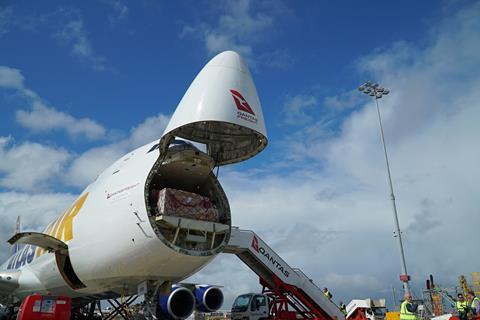Air cargo traffic was stable in July but demand continues to be constrained by the lack of bellyhold capacity, according to the latest monthly report from IATA.
Figures from the airline association show that demand in cargo tonne kilometre (CTK) terms fell by 13.5% year on year in July.
IATA said this is a modest improvement from the 16.6% year-on-year drop recorded in June and the 14.1% fall over the first seven months of the year.
However, cargo traffic is not increasing as fast as economic indicators suggest it should as a result of limited capacity, which in July was down by 31.2%.
The capacity decline was led by reductions in bellyhold space, down by 70.5% in July. This was, however, offset by a 28.8% increase in freighter capacity.
As a result of capacity decreasing faster than demand, load factors improved by 11.5 percentage points to 56.4%.
While economic indicators have diverged from air cargo performance over the last few months, there are some positive signs for the sector.

The airline association said that new export orders statistics – a leading indicator for air cargo – show that CTKs should continue to improve in the coming period.
IATA director general and chief executive Alexandre de Juniac said: “Economic indicators are improving, but we have not yet seen that fully reflected in growing air cargo shipments.
“That said, air cargo is much stronger than the passenger side of the business and one of our biggest challenges remains accommodating demand with severely reduced capacity.
“If borders remain closed, travel curtailed and passenger fleets grounded, the ability of air cargo to keep the global economy moving will be challenged.”
Looking at regional performance, airlines from the Asia Pacific region saw their cargo volumes drop by 17.7% year on year in July while capacity was down by 33.2%.
“After a robust initial recovery in May, month-on-month growth seasonally-adjusted, demand has softened,” IATA said.
North America-based carriers reported a 2.9% increase in cargo volumes during July as a result of strong demand on the transpacific, Asia-North America route, reflecting e-commerce demand for products manufactured in Asia. Capacity was down by 24.4% during the month.
Over in Europe, the region’s carriers registered a 22% year-on-year decline in July, while capacity was down by 36.5%.
IATA pointed out that this was an improvement on the 27.6% drop off recorded in June. However, it added: “Demand on most key trade lanes to/from the region remained weak.”
Middle East-based carriers reported a demand decline of 14.9% in July while capacity was reduced by 27.3%.
IATA said that demand had improved on June’s result, driven by the aggressive operational strategies of some of the region’s carriers.
Latin American carriers posted a 33.2% drop in year-on-year demand in July, down from a 28.6% decline in June, while capacity decreased by 49.2% on last year.
“The drop in both demand and capacity was the most severe of all regions,” IATA said. “The Covid-19 crisis is particularly challenging at present for airlines based in Latin America owing to strict lock-down measures. In July the Latin American air cargo market was smaller than the African market for the first time since these statistics have been reported in 1990.”
Finally, African airlines posted a contraction of 4% in July as the small Africa-Asia market continued to support the region’s performance. International capacity decreased 33.7%.
Damian Brett is the editor of Air Cargo News


























